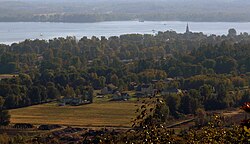Oka (Quebec)
| Oka | ||
|---|---|---|
 The village of Oka as seen from Mount Oka |
||
| Location in Quebec | ||
|
|
||
| State : |
|
|
| Province : | Quebec | |
| Administrative region : | Laurentides | |
| MRC or equivalent : | Deux-Montagnes | |
| Coordinates : | 45 ° 28 ′ N , 74 ° 5 ′ W | |
| Area : | 67.21 km² | |
| Residents : | 4726 (as of 2007) | |
| Population density : | 70.3 inhabitants / km² | |
| Time zone : | Eastern Time ( UTC − 5 ) | |
| Municipality number: | 72032 | |
| Postal code : | J0N | |
| Mayor : | Yvan Patry | |
| Website : | municipalite.oka.qc.ca | |
Oka is a village in the Canadian province of Québec , about 30 km from Montréal . It is on the Ottawa River . The Parc national d'Oka is located on the territory of the municipality of Oka . Oka is also known for its Oka cheese from the former Trappist Abbey Notre-Dame du Lac .
history
Artifacts document a 4,500-year Indian presence in the area of today's location. When the first European settlers arrived, the Mohawks used the area as a hunting ground.
In 1717 the governor of New France transferred the area to the Catholic Order of the Sulpizians , who founded a mission station there in 1721 under the name Mission du Lac des Deux-Montagnes . 1740–1742, the Sulpizians built the Calvaire d'Oka , a calvary that originally served to proselytize the indigenous population with the help of the Mohawks . The seven Stations of the Cross were among the most visited pilgrimage sites in the province of Québec from the end of the 19th century to the 1950s, with 30,000 pilgrims a year.
When the local post office opened in 1867, Oka was chosen as the place name. The name, which goes back to the Algonquin chief Paul Oka, means 'golden fish'.
In 1890 the Trappists founded the Ecole d'Agriculture d'Oka , which was affiliated to the agricultural faculty of the Université de Montréal . Today the building houses the École secondaire d'Oka .
From the 1930s onwards, the area became known to archaeologists as a site. In autumn 2007, 108 artefacts were found in the Parc national d'Oka , 85 of which were ceramic. In the following year, 1,669 more fragments were found, parts of which from a vase date back to 400 BC. and could be dated 500 AD. Another vase could be dated between 500 and 1000.
With the establishment of the Parc provincial d'Oka , the village became a tourist destination from the 1960s .
In 1990 Oka came into the focus of the international public due to the Oka crisis , when members of the Mohawk from the nearby Kanesatake reservation fought for months with the police and finally the Canadian army was deployed.
sons and daughters of the town
- Denis Harbor (1917–2009), singer
Individual evidence
- ↑ Sépaq (ed.), Oka National Park. Guide du visiteur - 2015 at: sepaq.com, accessed on August 17, 2015 (pdf, French).
- ↑ Portrait du parc at: sepaq.com, accessed on August 17, 2015 (French).
- ↑ a b c d Histoire et geographie at: municipalite.oka.qc.ca, accessed on August 17, 2015 (French).
- ↑ Gilles Piédalue, Colline du Calvaire d'Oka at: ameriquefrancaise.org, accessed on August 17, 2015 (French, English ).
